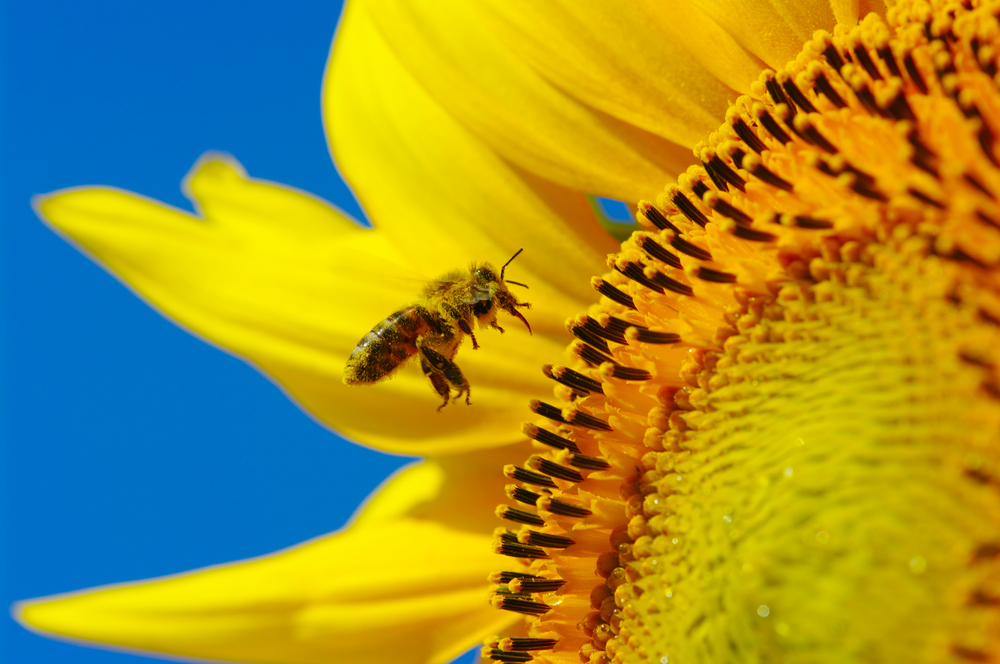The Great Sunflower Project
- May 6, 2015
- By Christy Peterson
I have become fascinated by bees in the last few years. Growing up, I learned about the importance of honeybees and sang exuberantly about “bringing home a baby bumblebee,” but that was the extent of my knowledge. (Are you singing the song now? Sorry about that!) Recently though, I’ve discovered that there are dozens of species of bees and wasps in my backyard alone, and about 115,000 species around the world.
The Great Sunflower Project is a citizen science project founded in 2008 to gather information about pollinator populations around the United States. Currently, the project has three focus areas:
- Safe Gardens for Pollinators, which focuses on gathering data about the effects of neonicotinoid pesticides on pollinators.
- Pollinator Friendly Plants Program, which seeks to discover which plants actually attract pollinators in different regions of the country.
- Great Pollinator Habitat Challenge, which asks participants to evaluate their current habitat and implement pollinator-related improvements.
Each of these programs is classroom-friendly. Though an account is required, data entry is not complicated. The Safe Gardens for Pollinators program asks participants to plant a specific type of sunflower plant, which could be done in a school garden plot or in large pots placed in a sunny area on campus. The Pollinator Friendly Plants Program tracks pollinator visits to specific kinds of plants. Again, these could be planted in a school garden or a collection of large pots.
In both cases, participants observe pollinator visits to a flower or specific group of flowers for a few minutes and record the number and type of pollinators they see. The ability to identify the exact species is not required.
Younger students might watch as a group, while older students could make observations individually or in pairs. Observation and safety protocol should be reviewed, and extra volunteer help with younger children would probably be a good idea. Students will need to be reminded not to try to catch the flower visitors and may need to be instructed about sitting quietly during observations.
Even if you don’t participate in the project itself, the Great Sunflower Project’s website has some good pollinator-related resources, from brand new identification cards to a whole page of teaching aids (see list below). Following is an activity that combines art, science, and writing that you might include with your study of bees or pollinators:
Activity—Scientist Bees and Poetry Flowers
Note: This project assumes you have already had each student create a bumblebee and a sunflower. Pinterest and other web resources are stuffed with ideas for making these, and I’ve included two links below to get you started.
You will need:
- Completed sunflower art piece for each student. You can select any project you like, but make sure the finished product has a large, black area in the center.
- Completed bumblebee art piece for each student. Again, any approach is fine, as long as the black and white stripes are wide enough to accommodate a line of text.
- White paper, some cut into strips that will fit within the bumblebee stripes.
- Sample texts, see Step 1 and list below.
Instructions:
- Introduce the idea that nonfiction texts can present information in different ways. Some are “just the facts,” while others present these facts using language that also employs aesthetic elements—metaphor, imagery, alliteration, etc. Share sample passages from books about bees that illustrate each type of writing (suggestions below).
- Ask students to write down five facts about bees they find interesting or unusual. This can be a review of information you’ve already presented or a research project to complete in class or at home.
- Invite students to think about the facts they’ve written down and use them to write a descriptive paragraph about bumblebees. Depending upon the age of your students, they may need more or less support for this task. The idea is to focus on using rich, descriptive language while still incorporating factual information.
- Hand out strips of white paper to each student. Have them write down their five facts on separate strips of paper and glue these to the stripes on their bumblebees.
- Have students write their paragraphs on the white paper or type and print them. In either case, the paragraphs need to fit within the black center of the sunflowers.
- Cut out and paste the paragraphs to the sunflowers.
Extension: Instead of descriptive paragraphs, you could take the time to teach students about writing simple haiku poems and mount these to the center of the sunflowers. There is a link below about teaching haiku to children.
Resources and Books
- Free Bee Identification Cards from The Great Sunflower Project (must be logged in)
- List of Teaching Resources from The Great Sunflower Project
- Bumblebee Art Project
- Sunflower Art Project
- “Teaching Haiku to Children,” by David E. LeCount
- http://simplyhaiku.com/SHv2n5/features/David_LeCount_Feature.html
- Zoom in on Bees, by Melissa Stewart
- The Honey Makers, by Gail Gibbons
- Winter Bees & Other Poems of the Cold, by Joyce Sidman
- Butterfly Eyes and Other Secrets of the Meadow, by Joyce Sidman

Kids Discover Talks with Television Lighting Designer Christopher Landy About the Rockefeller Center Christmas Tree Lighting
- December 9, 2025

It’s the Most Wonderful Time of the Year… For Community Service Projects!
- December 8, 2025

The Rockefeller Center Christmas Tree Lights the 2025 Holiday Season in New York City
- December 3, 2025
